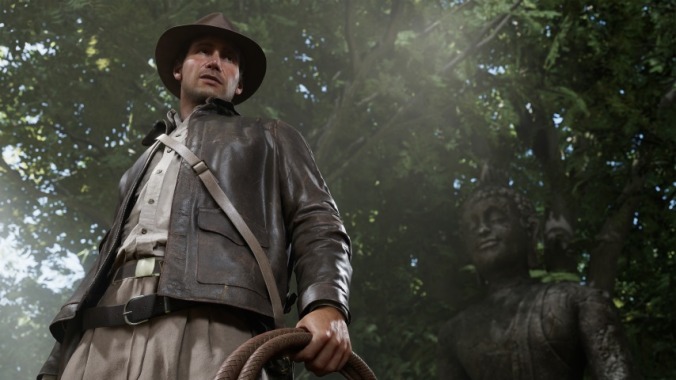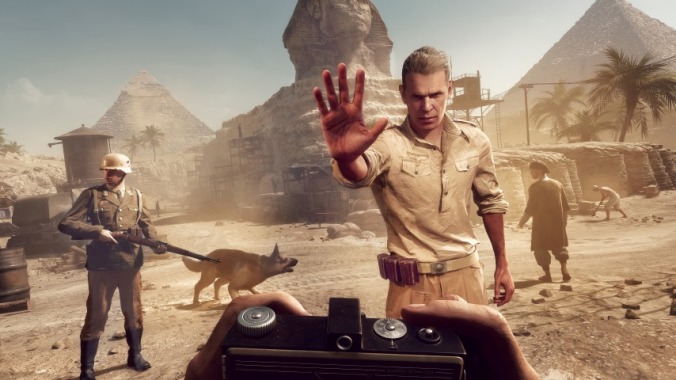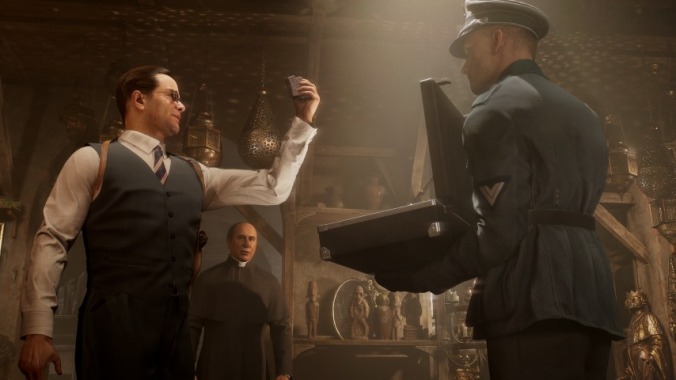Indiana Jones and the Great Circle: Indy’s New Game Whips

When I was a kid old guys didn’t play videogames because they were old guys and old guys were men and men didn’t “play” anything but the ponies and sports with the fellas. Today I am an old guy and I make my living playing games and writing about them for people who I assume are usually not old guys and probably don’t get my old guy jokes and references. The game I’ve been playing most lately, Indiana Jones and the Great Circle, is an ultimate old guy game, though, one made with our aging hopes, desires, and expectations constantly in mind. This one’s for us, old guys of the world, and the arrested development and obsession with childhood entertainment that keeps us talking about 40-year-old toys and kids’ movies instead of doing sports with our goodtime buddies like the emotionally inert old guys of yore.
Indiana Jones isn’t even just an old guy at this point. Like me and my friends and the American election system, the good professor is an absolute relic. A swashbuckling archeologist scrounging up ancient stones and idols around the globe, but in a way that’s somehow “ethical” and “respectful” of other cultures, usually during the build-up to (or aftermath of) the defining military event of our modern world? I don’t know what could seem more out-of-touch to the non-old guys of today, and more perfectly in sync with what I find unquestionably entertaining.
Still, an Indiana Jones game by the modern Wolfenstein studio MachineGames seems like a lay-up (that’s a sports term, non-old guys). The worldwide leader in movie-inspired Nazi-killing games getting their mitts on the preeminent cinematic Nazi puncher of the post-war era? Another playable movie designed by Jens Andersson, who helped turn the fifth-rate comic book The Darkness into a surprisingly smart and poignant game, and whose game based on The Chronicles of Riddick did a lot to rehab the bad name of Vin Diesel’s bomb of a movie? This should be an ideal match, like social media and depression, or old guys and emotional distance.
Indiana Jones and the Great Circle lives up to those expectations—sometimes. And when it doesn’t, it’s easy to see why. At its best The Great Circle offers up esoteric mysteries and hard-to-crack puzzles in ancient, exotic milieus, punctuated by rousing setpieces right out of a Spielberg/Lucas movie; at its worst it’s a sluggish, patience-trying stealth game by a studio best known for fast-paced first-person shooters. The highs are tremendous, and not in short supply; when your autosave sticks you in the middle of a Nazi compound that has to be slowly, methodically crawled through, though, with almost every engagement with the enemy leading to a quick death, The Great Circle becomes the kind of slog people accuse the last two Indiana Jones movies of being.

Yes, set aside your memories of Wolfenstein and fantasies of guns a-blazin’. That ain’t Indiana and so it isn’t The Great Circle. Most of Indy’s time in this game is spent lurking on the edges of Nazi and Fascist (with a capital F, so you know it’s Mussolini’s real-deal Italian fascism) excavation sites, trying to find the conveniently highlighted doo-dad that will trigger the next story-delivering cutscene. Knock a guy out from behind, if you have to, even confront them in a straight-on boxing match, but if they’re packing or have any friends nearby or even hint at blowing a whistle you’ll need to be careful. Each major open-world location is full of side quests, of course, where you’ll help a nun find the centuries-old diary of a mad priest, or a well-heeled British-Egyptian “patron of history” liberate Egyptian artifacts from the Nazis. Although fists are Indy’s weapons of choice whenever he’s forced into a fight, he obviously has his whip on hand, which is as useful at disarming enemies as it is for swinging and climbing over obstacles; he also keeps a small pistol at all times, and can make use of the rifles and machine guns dropped by the bad guys, but it’s almost always a bad idea to fire a gun in this game. They’re loud, they’re messy, and no matter what kind of firepower you’re working with, your enemies will always have a lot more.
All this slinking around fits Indy—he’s never been a fight-first kind of guy—but it also points at one of the fundamental issues with translating this particular character to this kind of big budget game with broad, mainstream commercial aspirations. Watching Harrison Ford figure things out on screen every 20 minutes or so between exhilarating action scenes is way more fun than spending hours in a lethal version of hide’n’seek just to pad out the runtime and keep the story wheel turning. When a mission works out smoothly—when you find the right hidden entrance that lets you get into that Thai temple and grab the Germans’ gold without being noticed, after a few too-long trial-and-error attempts to get through the Nazi camp that surrounds it—The Great Circle pays out more than it asks from you. When one doesn’t, though, and you keep stumbling into Bavarian bruisers who send you back to the last checkpoint and erase minutes of play at a time, it’s all just a little frustrating.
The Great Circle lands on the best combo of videogame and Indiana Jones movie when it changes things up. A daring escape via a stolen Chinese plane, with you having to shoot down the fighters on your tail, feels like something that would happen in one of these movies and keeps a fast, steady, exciting pace. (It’s also over within a few minutes, just like a movie scene would be.) A chapter-ending encounter where you have to combine Indy’s expertise of the ancient and esoteric with beating a big guy against the head with large metal rods turns the basic concept of stealth into something active and violent. Moments like these don’t happen enough, but always work when they do.
